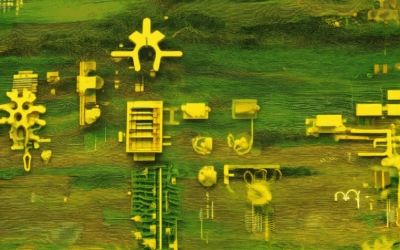In an era where innovation drives progress, the integration of digital tools has emerged as a transformative force across industries. Among the most pressing challenges of our time is achieving sustainable growth, a goal that requires not only environmental responsibility but also smart, efficient solutions. This comprehensive guide delves into how cutting-edge digital tools are becoming catalysts for sustainable growth, enabling businesses and communities to thrive while preserving the planet for future generations. By exploring technological advancements, real-world applications, and the principles that underpin their use, this article will shed light on the intersection of innovation and sustainability. From understanding the essential tools to discovering actionable strategies, we will examine how digital solutions are paving the way for a more sustainable tomorrow.

Technological Tools for Sustainable Development
- Renewable Energy Technologies
- Solar Panels
- Wind Turbines
- Hydroelectric Power Plants
- Biomass Energy Systems
- Circular Economy Innovations
- Recycling Machines
- Waste-to-Energy Plants
- Product Life Extension Technologies
- Biodegradable Materials
- Smart City Solutions
- Smart Meters
- Traffic Management Systems
- Energy-Efficient Building Designs
- Waste Management Automation
- Carbon Capture and Storage
- Carbon Dioxide Removal Technologies
- Geothermal Energy Storage
- Blue Hydrogen Production
- Ocean Absorption Technologies
- Digital Monitoring and Reporting Tools
- Global Positioning Systems (GPS)
- Environmental Monitoring Sensors
- Big Data Analytics Platforms
- Real-Time Emission Tracking Systems
- Behavioral Change and Engagement Tools
- Gamification Applications
- Community-Based Social Networking
- Eco-Friendly Rewards Programs
- Local Food Sharing Platforms
- Water Conservation and Management Tools
- Desalination Technologies
- Water-Efficient Irrigation Systems
- Stormwater Harvesting Systems
- Aquifer Replenishment Technologies
- Policy and Governance Tools
- Blockchain for Supply Chain Transparency
- AI-Powered Regulatory Compliance Systems
- Sustainability Impact Assessment Software
- Public Participation Platforms
Digital Technology and Sustainability
Digital technology plays a pivotal role in advancing sustainability efforts, offering innovative solutions to global environmental challenges. By leveraging digital tools, industries can significantly reduce their ecological footprint while enhancing operational efficiency.
Reducing Resource Consumption
- Smart automation systems optimize energy usage in manufacturing and logistics, minimizing waste and resource depletion.
- IoT-enabled sensors monitor resource consumption in real-time, enabling proactive decision-making to prevent inefficiencies.
- Cloud-based analytics tools allow businesses to track and analyze resource usage patterns, identifying areas for improvement.
Promoting Renewable Energy Adoption
- Digital platforms facilitate the adoption of renewable energy sources by providing information on solar, wind, and geothermal energy options.
- Smart grids powered by digital infrastructure integrate renewable energy sources into the grid, ensuring a stable energy supply.
- Virtual power plants managed through digital platforms enable aggregated energy production from distributed renewable sources.
Enhancing Operational Efficiency
- AI-driven predictive maintenance systems predict equipment failures, reducing downtime and resource waste.
- Digital twins simulate industrial processes to identify inefficiencies and optimize resource utilization.
- Automation and robotics replace manual labor in high-resource-consuming tasks, minimizing material use and energy expenditure.
Fostering a Circular Economy
- Blockchain technology tracks product lifecycles, ensuring materials are reused or recycled, thereby reducing waste.
- Digital platforms connect suppliers, manufacturers, and recyclers, facilitating closed-loop systems for resource management.
- E-waste management systems powered by digital tools enable efficient recycling and disposal of electronic products.
Enabling Smart Cities
- Smart city initiatives use digital technology to optimize urban planning, transportation, and energy distribution.
- Digital platforms collect and analyze data on air quality, traffic, and waste management, enabling better decision-making.
- IoT-enabled infrastructure integrates various systems, improving resource allocation and reducing environmental impact.
Facilitating Collaboration and Innovation
- Digital platforms serve as hubs for collaboration among governments, businesses, and NGOs working on sustainability projects.
- Open-source technologies democratize access to tools and data, encouraging innovation in sustainable practices.
- Digital twin cities prototype future urban environments, testing sustainability solutions before full-scale implementation.
Driving Public Awareness and Engagement
- Digital campaigns and educational programs raise awareness about sustainability issues and encourage individual and collective action.
- Mobile apps provide real-time updates on environmental conditions, enabling informed decision-making by citizens.
- Virtual reality experiences simulate the impacts of sustainability initiatives, making abstract concepts more tangible.
By harnessing digital technology, we can create a more sustainable future, addressing environmental challenges with innovative solutions while ensuring long-term economic growth.
Learn more about digital transformation and sustainable solutions at Iterati .

The 5 Cs of Sustainability
The 5 Cs of sustainability provide a holistic framework for understanding and achieving sustainable development. These principles guide organizations and individuals toward creating a more equitable, ethical, and environmentally responsible world. Below is a breakdown of each component:
- Clean: Focuses on environmental sustainability through actions that reduce harm to ecosystems and promote resource efficiency. This includes reducing carbon emissions, conserving water, and minimizing waste.
- Community: Emphasizes social responsibility and collaboration. It involves fostering strong relationships with local communities, supporting social equity, and contributing to the well-being of society as a whole.
- Culture: Relates to the shared values and beliefs within an organization. A sustainable culture encourages continuous improvement, innovation, and ethical decision-making.
- Care: Highlights the importance of caring for people and the planet. This includes ensuring fair labor practices, human rights, and sustainable resource management.
- Corporate Governance: Involves establishing policies and practices that ensure ethical business operations. It includes transparency, accountability, and aligning corporate strategies with global sustainability goals.
By integrating these five core components, organizations can create a sustainable future that benefits both society and the environment.

What Are Digital Pathways for Sustainable Development?
Digital pathways for sustainable development refer to the utilization of digital tools, platforms, and technologies to foster innovative solutions and empower individuals, particularly youth, to contribute to sustainable development initiatives. These pathways leverage modern technologies to address global challenges such as climate change, social inequality, and resource scarcity.
Key Components of Digital Pathways
1. Empowerment of Youth and Future Generations
Digital pathways play a pivotal role in empowering young people to become active participants in sustainable development. Platforms like Iterati provide resources and tools that enable youth to explore innovative solutions to pressing environmental and social issues. By fostering creativity and technical skills, these platforms prepare the next generation to lead sustainable efforts.
2. Collaboration Between Sectors
Digital pathways facilitate cross-sector collaboration, bridging gaps between governments, businesses, NGOs, and local communities. Tools like InnoCentive and IdeaLab encourage collaborative problem-solving, ensuring that diverse perspectives contribute to sustainable outcomes.
3. Technological Innovations
Digital pathways integrate cutting-edge technologies such as artificial intelligence, blockchain, Internet of Things (IoT), and big data analytics. These tools enhance efficiency, transparency, and scalability in sustainable development projects. For instance, IBM ‘s Watson AI platform has been used to optimize renewable energy solutions.
4. Monitoring and Evaluation Frameworks
Effective implementation of digital pathways requires robust monitoring and evaluation mechanisms. Platforms like KIVU Congo offer digital dashboards that track progress, ensuring that sustainable development initiatives remain on course. This transparency is essential for accountability and continuous improvement.
5. Community Engagement
Digital pathways also serve as bridges between developers and communities. Through platforms like TEDx , local leaders and stakeholders can share ideas and collaborate on sustainable projects. This grassroots involvement ensures that solutions are culturally relevant and community-driven.
Best Practices for Implementing Digital Pathways
To maximize the impact of digital pathways, it is crucial to adopt open-source tools and participatory design processes. Platforms like OpenStreetMap allow communities to map their resources and track environmental changes. Additionally, incorporating feedback loops into project planning ensures that initiatives evolve based on real-time insights.
By leveraging digital pathways, we can unlock the full potential of sustainable development, creating a brighter future for generations to come.
What Are the 5 Main Areas of Digital Transformation?
Digital transformation encompasses several key domains that drive organizational change and innovation. Here are the five primary areas:
- Cloud Computing : Migrating IT infrastructure to the cloud enables scalability, cost-efficiency, and improved collaboration. Platforms like AWS, Azure, and Google Cloud provide robust solutions for businesses to modernize their systems.
- Big Data and Analytics : Leveraging large datasets to derive meaningful insights is crucial for decision-making. Tools like Tableau and Power BI help organizations gain a competitive edge through data-driven strategies.
- Artificial Intelligence and Machine Learning : Integrating AI and ML into operations automates tasks and enhances decision-making. Applications in natural language processing, predictive analytics, and automation are revolutionizing industries like healthcare and finance.
- Cybersecurity : Protecting digital assets and customer data is paramount. Solutions like firewalls, encryption, and identity management ensure secure environments, mitigating risks associated with cyber threats.
- Customer Experience (CX) : Enhancing interactions through digital channels improves satisfaction and loyalty. Personalized apps and chatbot technology enable seamless engagement, driving customer retention and brand advocacy.
These areas collectively drive innovation, efficiency, and growth, positioning organizations for long-term success in a rapidly evolving digital landscape.

Sustainable Digitalization
Sustainable digitalization refers to the integration of sustainable practices into the development, implementation, and use of digital technologies. This approach ensures that technological advancements align with environmental, social, and economic goals, fostering long-term growth while minimizing negative impacts on ecosystems and communities.
Key Components of Sustainable Digitalization
- Sustainability by Design
Sustainable digitalization prioritizes the consideration of environmental and social factors during the creation of digital tools and systems. This ensures that technologies are developed with ethical considerations and sustainability in mind throughout their lifecycle. - Ethical Considerations
Ethical digitalization focuses on fairness, transparency, and inclusivity. It aims to address issues like digital divide, data privacy, and algorithmic bias, ensuring that digital solutions benefit all stakeholders equitably. - Circular Economy Principles
Sustainable digitalization promotes the circular economy, where waste is minimized, and resources are reused. This applies to hardware, software, and data, ensuring that digital assets are optimized for longevity and recyclability. - Green IT Practices
Green IT involves reducing the environmental footprint of digital infrastructure through energy-efficient technologies, renewable energy sources, and optimized resource usage. This includes minimizing carbon emissions and promoting sustainable cloud computing. - Regulatory Compliance and Standards
Adherence to international standards and regulations ensures that digitalization efforts meet sustainability objectives. Governments and organizations play a crucial role in establishing frameworks that guide sustainable practices.
Role of Technology Providers and Policymakers
Technology providers have a responsibility to develop and promote sustainable digital solutions. This includes designing energy-efficient hardware, creating AI systems with ethical guidelines, and implementing data management practices that respect privacy and security.
Policymakers and regulators also play a key role in shaping the landscape of sustainable digitalization. They can enforce laws and incentives that encourage companies to adopt eco-friendly practices and ensure that digital technologies contribute positively to societal well-being.
Examples of Sustainable Digitalization in Action
- AI for Social Good : Using AI to solve real-world problems like healthcare access and environmental conservation.
- Smart Cities : Implementing IoT and data analytics to create efficient urban environments while addressing sustainability challenges.
- Renewable Energy Integration : Leveraging digital platforms to manage and distribute renewable energy sources effectively.
Benefits of Sustainable Digitalization
Adopting sustainable digitalization practices leads to numerous benefits, including:
- Cost Savings : Reducing energy consumption and optimizing resource use lowers operational costs.
- Innovation : Fostering creativity and innovation by addressing complex global challenges.
- Regulatory Compliance : Ensuring alignment with emerging regulations and market demands.
Conclusion
Sustainable digitalization is not just a trend but a necessary evolution in how we approach technology. By integrating sustainability into every aspect of digital development, we can create systems that drive progress while preserving the planet for future generations. Collaboration between governments, businesses, and civil society is essential to achieving this vision.




0 Comments